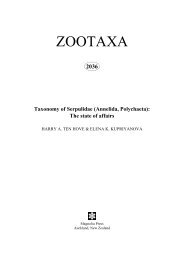Create successful ePaper yourself
Turn your PDF publications into a flip-book with our unique Google optimized e-Paper software.
Species delimited under the PSC function as hypotheses and these can be tested (Wheeler & Platnick<br />
2000). This test depends on distinguishing characters from traits, i.e., the test is, that characters are not traits,<br />
and traits are not characters. In the former case, a supposed character may turn out to be distributed as a trait.<br />
Such a misinterpretation would give an overestimation of the number of species. In the latter case, a supposed<br />
trait may be distributed as a character, giving an underestimation of the number of species.<br />
Data matrix construction<br />
Eight hundred and fifty-one specimens from the following herbaria were examined and scored: A, AAU, BH,<br />
BM, CEN, COAH, COL, CR, F, GH, HEPH, IBGE, INB, INPA, K, M, MG, MICH, MO, NY, P, PMA, R, S,<br />
SPF, UB, and US (herbarium abbreviations from Holmgren et al. 1990). Fragmentary type specimens from<br />
some herbaria (e.g., M, P) were examined but not necessarily scored. Sometimes, more than one duplicate of<br />
a collection was used in scoring. All sterile specimens, including types, were excluded from this study<br />
because of the difficulty of identifying them. There are two exceptions. Specimens of Desmoncus cirrhifer<br />
and D. stans can be unequivocally identified even when sterile, and all specimens of these species were<br />
included.<br />
Morphological attributes that could be scored or measured from specimens were divided into qualitative<br />
(binary or multistate) or quantitative (continuous, meristic) variables. A search was made for qualitative<br />
variables in which two or more states of the variable were present among the specimens and could be scored<br />
unequivocally. This search was based on a survey of specimens. A dissecting microscope was used to survey<br />
floral variables. Sixteen qualitative variables were found and scored (Appendix I).<br />
A search was made for quantitative variables that could be taken from specimen labels (where, in case of<br />
ranges, median values were used) or measured from specimens. Variables were counted or measured with a<br />
ruler, digital calipers, or protractor. Sixteen quantitative variables were found and scored (Appendix II). Two<br />
are from stems, six from leaves, and eight from reproductive structures. Thirteen are continuous and three are<br />
meristic.<br />
A data matrix was constructed with specimens as rows and variables as columns (http://sciweb.nybg.org/<br />
Science2/res/Henderson/Desmoncus.xls.zip). Additional columns recorded a specimen identification number,<br />
collector, collector’s number, herbarium, country, latitude, longitude, and elevation. Latitude and longitude<br />
were taken from the specimen label, when available. On specimens lacking coordinates, these were estimated<br />
from the collection locality using either maps or electronic gazetteers.<br />
For each of the 851 specimens in the matrix, three spatial variables and 32 morphological variables were<br />
recorded, giving a potential total of 29,785 data points. However, approximately 46% of these potential data is<br />
missing in the matrix. Specimens are often fragmentary or incomplete, and various organs are often missing<br />
(especially staminate flowers). Data on plant height and stem branching are often missing from labels.<br />
Data analyses<br />
Some inferential statistics were used in this study. Although random samples are required for statistical<br />
inference, the samples of herbarium specimens are not random. However, there is no reason to believe that<br />
collectors favored any particular kind of specimen over others. Therefore inferential statistics were used, but<br />
the results should be considered accordingly. Statistical analyses were carried out using the programs NTSYS<br />
(Rohlf 2000) and Systat (Wilkinson 1997). Specimens with missing values were excluded. Analyses are thus<br />
based on subsets of the data. Because some quantitative variables were not normally distributed, data were<br />
log 10 -transformed before analysis.<br />
Species delimitation<br />
All specimens were assigned a preliminary species identification, either based on a previous determination or<br />
A REVISION OF DESMONCUS (ARECACEAE)<br />
Phytotaxa 35 © 2011 <strong>Magnolia</strong> <strong>Press</strong> 5
















